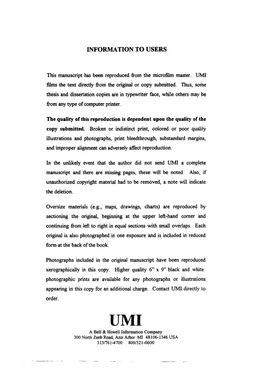| dc.contributor.advisor | Butler, Charles E., | en_US |
| dc.contributor.author | Pouretedal, Mohsen. | en_US |
| dc.date.accessioned | 2013-08-16T12:29:46Z | |
| dc.date.available | 2013-08-16T12:29:46Z | |
| dc.date.issued | 1997 | en_US |
| dc.identifier.uri | https://hdl.handle.net/11244/5496 | |
| dc.description.abstract | The population selected for this study was comprised of the entire groups of upper and middle-managers of the Oklahoma Department of Corrections. This agency was selected based on information gathered on its activities as reported to the Quality Oklahoma Office, and elapsed an time since the inception of training in total quality management in the agency. Seventy-five (75) questionnaires were eventually distributed. Final results were based on fifty-four (54) completed and returned instruments. | en_US |
| dc.description.abstract | The results of this study indicated a possibility that the contingency factors may appropriately describe necessary behaviors for implementing total quality management. This was also reflected in respondents' views on the success of total quality management in the agency, and their own areas, and their perceptions of contingency factors. The results also indicated a distinct difference between respondents with varying ethnic background and their perceptions of the contingency factors. Perceptions of who constitutes customer(s) in the agency were also found to be an indicator of responses to the contingency factors. Age, educational background, and leadership styles of the respondents were not shown to effect their responses to the contingency factors. | en_US |
| dc.description.abstract | The theoretical basis for this study stemmed from conceptualizations of contingency factors internal distributive, integrative/sociemotional, and boundary exchange. Leadership styles described as transformational, transactional, and representational formed the basis of probing leadership characteristics of the participants. Both the contingency factors, and leadership styles were incorporated in developing the data gathering questionnaire. The questionnaire also solicited demographic and other data necessary for the final analysis and interpretation of the results and for answering the proposed research questions. | en_US |
| dc.description.abstract | The purpose of this study was to examine the perceptions of upper and middle-managers in a state agency regarding behaviors necessary for successful implementation of total quality management in the Oklahoma Department of Corrections. Additionally, this study sought to ascertain self-reported leadership styles of the upper and middle-managers and the effects of the same on these managers' perceptions regarding total quality management implementation. The targeted population was also probed as to the level of education, race, gender, years of service, and understanding of the identity of the customers of the department. This additional information was necessary in later analysis of the data, and an examination of recognizable relationships between these factors and reported perceptions of total quality management behaviors. | en_US |
| dc.format.extent | xii, 134 leaves ; | en_US |
| dc.subject | Local government Management. | en_US |
| dc.subject | Total quality management. | en_US |
| dc.subject | Sociology, Criminology and Penology. | en_US |
| dc.subject | Business Administration, Management. | en_US |
| dc.subject | Total quality management in government. | en_US |
| dc.subject | Leadership. | en_US |
| dc.subject | Political Science, Public Administration. | en_US |
| dc.subject | Engineering, Industrial. | en_US |
| dc.title | Total Quality Management implementation and leadership perspectives in a state agency. | en_US |
| dc.type | Thesis | en_US |
| dc.thesis.degree | Ph.D. | en_US |
| dc.thesis.degreeDiscipline | Department of Educational Leadership and Policy Studies | en_US |
| dc.note | Major Professor: Charles E. Butler. | en_US |
| dc.note | Source: Dissertation Abstracts International, Volume: 58-03, Section: A, page: 0984. | en_US |
| ou.identifier | (UMI)AAI9728716 | en_US |
| ou.group | Jeannine Rainbolt College of Education::Department of Educational Leadership and Policy Studies | |
